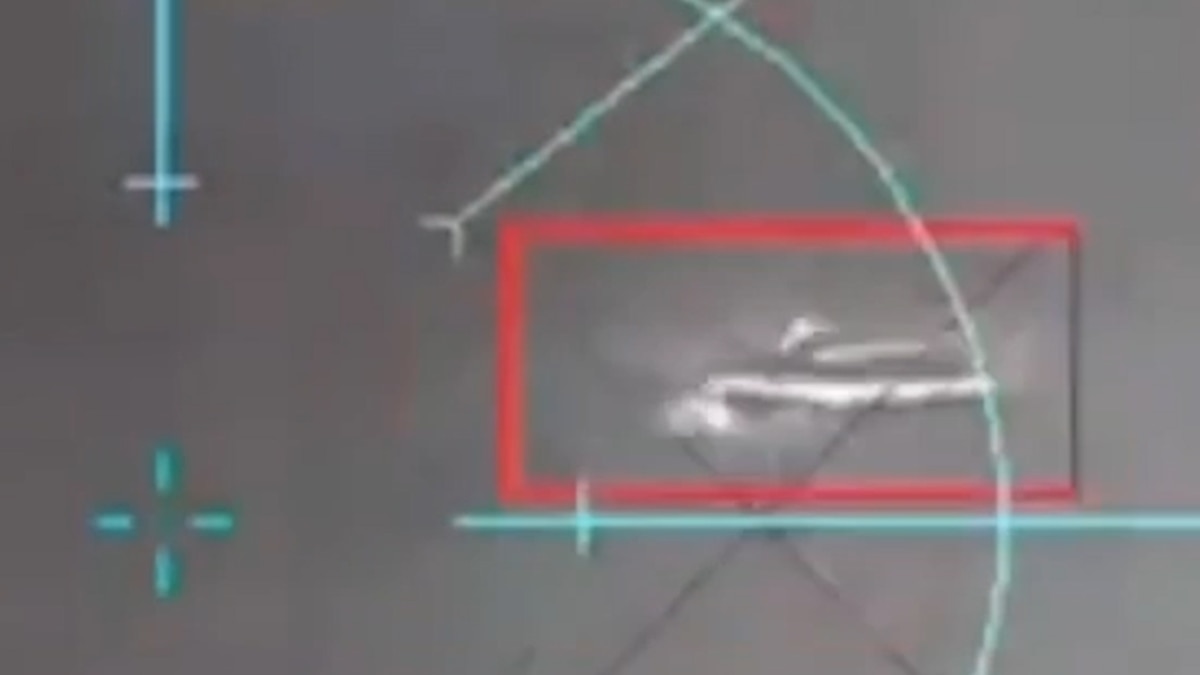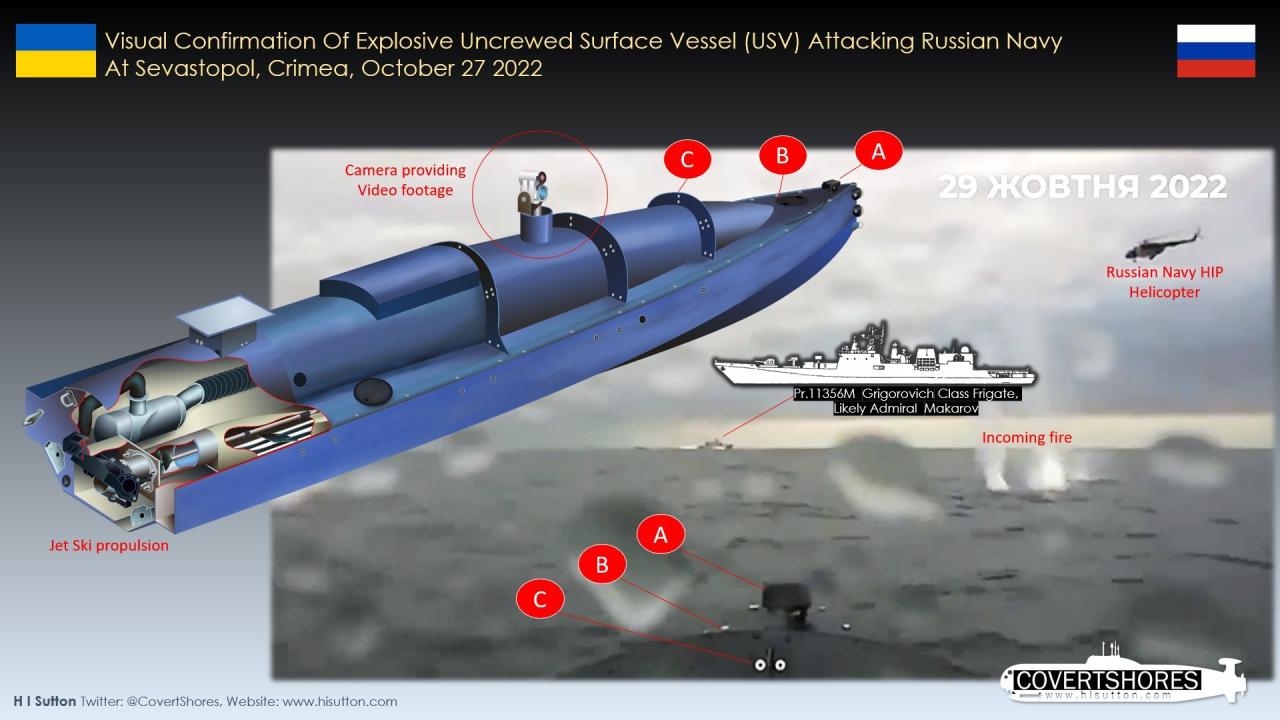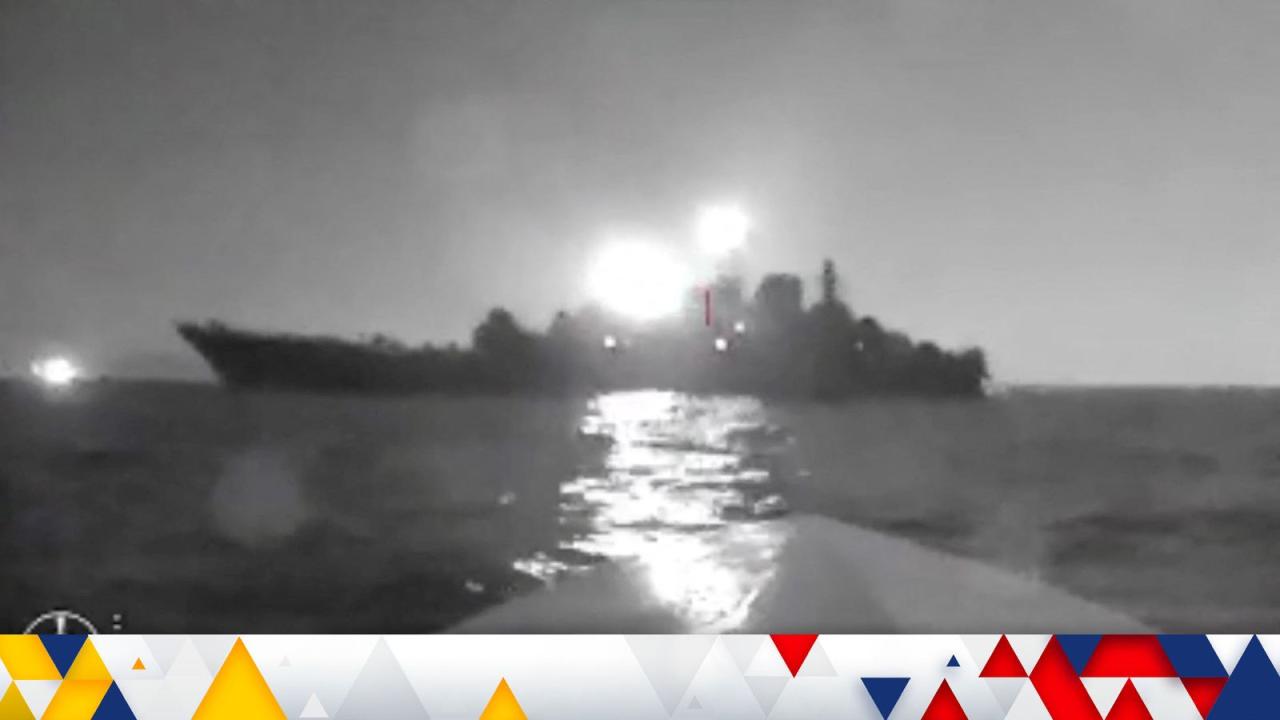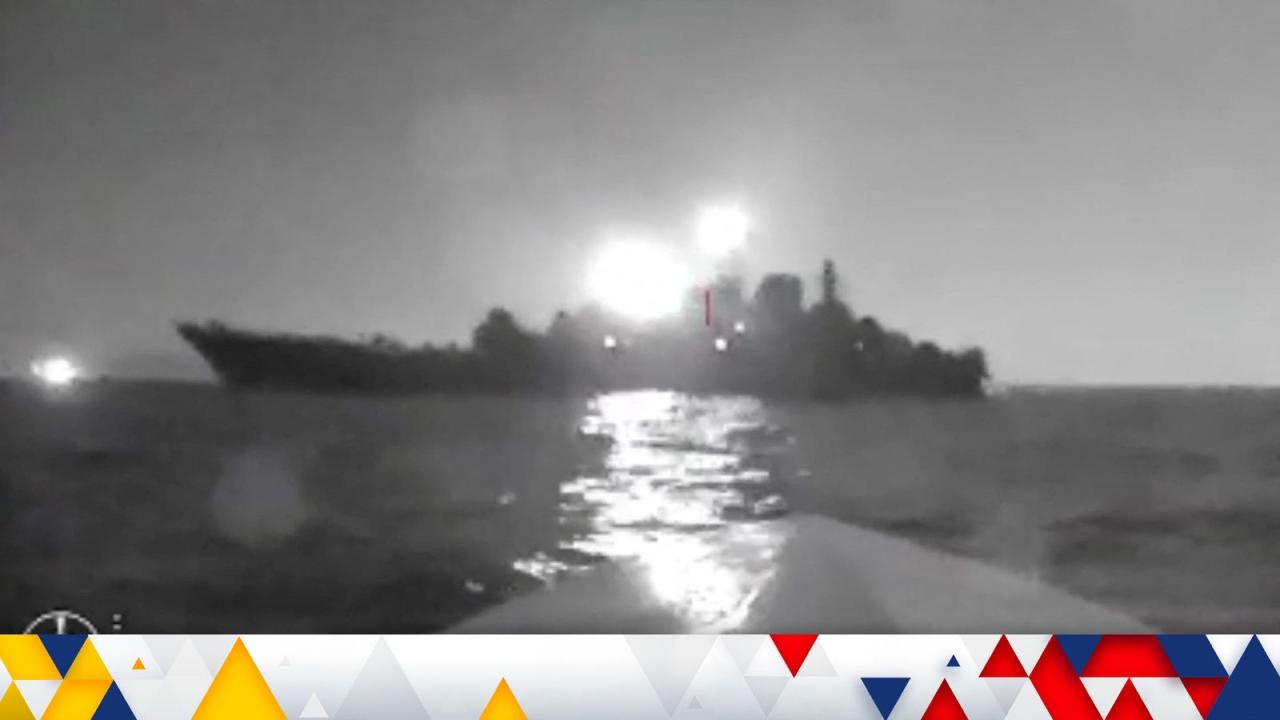Ukrainian sea drones are rapidly changing naval warfare. These unmanned vessels, ranging from small, expendable craft to more sophisticated autonomous platforms, are proving remarkably effective in asymmetric conflict. This exploration delves into their design, deployment, impact, and future potential, offering a comprehensive overview of this burgeoning technology.
We’ll examine various drone types, comparing their capabilities and exploring the tactical advantages they offer. We’ll also look at the technological advancements driving their development, from propulsion systems to AI integration, and consider the countermeasures being developed to combat them. Finally, we’ll speculate on the future of this technology and its potential implications for naval strategy worldwide.
Ukrainian Sea Drone Types

Ukraine’s sea drone program has rapidly evolved, deploying a diverse range of unmanned surface vessels (USVs) for various maritime operations. These drones vary significantly in size, capabilities, and intended roles, reflecting the innovative and adaptive nature of Ukrainian defense strategies.
Sea Drone Designs and Functionalities
Ukrainian sea drones encompass a spectrum of designs, from smaller, expendable craft designed for single-use missions to larger, more sophisticated drones capable of carrying heavier payloads and operating for extended periods. Smaller drones might focus on anti-ship capabilities, while larger models could incorporate reconnaissance, surveillance, and mine-laying functionalities. The specific design is often tailored to the mission requirements.
Comparison of Ukrainian Sea Drone Models
Direct specifications on payload capacity, range, and speed for specific Ukrainian sea drone models are often kept confidential for security reasons. However, publicly available information suggests a considerable range in capabilities. Smaller drones might have limited range and payload, focusing on speed and maneuverability for quick strikes, while larger drones prioritize endurance and payload capacity for longer missions.
| Type | Payload (Estimated) | Range (Estimated) | Speed (Estimated) |
|---|---|---|---|
| Small Attack Drone | Up to 100 kg | Up to 50 km | 30+ knots |
| Medium Reconnaissance Drone | Up to 500 kg | Up to 200 km | 15-20 knots |
| Large Mine-laying Drone | Up to 1000 kg | Up to 500 km | 10-15 knots |
Note: These are estimations based on publicly available information and should be considered approximate.
Ukrainian sea drones are causing a stir, showcasing impressive advancements in naval technology. Thinking about the scale of such unmanned operations makes you consider other forms of unmanned aerial technology, like the tragic events surrounding the fullerton plane crash , highlighting the importance of safety protocols across all types of unmanned vehicles. Ultimately, the lessons learned from both incidents could inform the future development and safe deployment of Ukrainian sea drones and similar tech.
Technological Advancements in Ukrainian Sea Drone Designs
Ukrainian sea drone technology demonstrates ongoing innovation. Advancements include improved propulsion systems for increased speed and endurance, enhanced navigation and guidance systems using GPS and inertial navigation, and more robust communication systems for reliable control and data transmission, even in challenging environments.
Operational Use of Ukrainian Sea Drones
Ukrainian sea drones have played a significant role in the ongoing conflict, demonstrating their effectiveness in various maritime operations.
Ukrainian sea drones are proving to be surprisingly effective, showcasing the adaptability of drone technology in warfare. It’s a far cry from the dazzling displays of coordinated drones like those you’ll see in the spectacular China New Year’s drone show , but both highlight the potential of unmanned aerial vehicles. The precision and scale involved in both applications are impressive, showing just how versatile drones can be.
The future of drone technology, both militarily and commercially, looks bright.
Strategic Roles in Maritime Operations
These drones are employed for various tasks, including reconnaissance and surveillance of enemy naval movements, attacks on enemy ships and infrastructure, mine-laying operations, and disrupting enemy supply lines. Their low cost and expendable nature make them a highly effective asymmetric warfare tool.
Successful Deployments of Ukrainian Sea Drones
While specific details of successful deployments are often kept classified, reports indicate the effective use of Ukrainian sea drones in attacks on Russian naval vessels and coastal infrastructure. These attacks have demonstrated the drones’ capability to inflict damage and disrupt enemy operations at a relatively low cost.
Tactics Employed When Using Ukrainian Sea Drones
Tactics vary depending on the mission objective and the type of drone used. Swarm tactics, where multiple drones coordinate their attacks, have been suggested as a particularly effective strategy, overwhelming enemy defenses and increasing the chances of success.
Limitations and Challenges Associated with Operational Use
Challenges include vulnerability to countermeasures such as electronic warfare, anti-drone systems, and physical interception. Environmental factors, such as weather conditions and sea state, can also affect drone operational effectiveness. Maintaining communication and control over long ranges can also be challenging.
Technological Aspects of Ukrainian Sea Drones
The technology underpinning Ukrainian sea drones is a crucial element in their effectiveness. Understanding the key components provides insight into their capabilities and limitations.
Propulsion Systems
Various propulsion systems are likely employed, ranging from simple outboard motors for smaller drones to more sophisticated jet or propeller systems for larger, longer-range models. The choice of propulsion system is influenced by factors such as speed, endurance, and payload capacity.
Navigation and Guidance Systems
Navigation and guidance systems are critical for successful drone operation. GPS, inertial navigation systems, and potentially other advanced sensor technologies are likely incorporated to ensure accurate positioning and path planning, even in GPS-denied environments.
Communication Systems
Reliable communication is vital for real-time control and data transmission. Secure, long-range communication systems, potentially incorporating various frequency bands and encryption techniques, are essential for effective drone operation.
Key Technological Components of a Typical Ukrainian Sea Drone
- Propulsion System (Motor, Propeller/Jet)
- Navigation System (GPS, Inertial Navigation)
- Guidance System (Pre-programmed path, autonomous navigation)
- Communication System (Radio, Satellite)
- Payload (Warhead, Sensors, Cameras)
- Power System (Batteries, Fuel Cells)
- Control System (Onboard computer, remote control)
Impact and Implications of Ukrainian Sea Drone Technology
The development and deployment of Ukrainian sea drones have significant implications for naval warfare and future naval strategies.
Impact on Naval Warfare
Ukrainian sea drones have demonstrated the potential to disrupt traditional naval power dynamics. Their relatively low cost and high effectiveness make them a potent tool for asymmetric warfare, challenging the dominance of larger, more expensive naval vessels.
Ukrainian sea drones are making waves in naval warfare, showcasing impressive autonomous capabilities. It’s a far cry from the dazzling spectacle of a coordinated drone light show, like the one you can check out at the shanghai drone show , but both highlight the rapid advancements in drone technology. Thinking about the precision needed for those Shanghai displays really makes you appreciate the challenges of targeting with a sea drone.
Cost-Effectiveness Compared to Traditional Naval Vessels
The cost-effectiveness of sea drones compared to traditional naval vessels is a significant advantage. A single drone can be produced and deployed at a fraction of the cost of a conventional warship, making them a more affordable option for smaller navies or for carrying out specific, limited missions.
Implications for Future Naval Strategies
The success of Ukrainian sea drones is likely to influence future naval strategies, prompting the development of more effective countermeasures and the integration of unmanned systems into naval forces. The focus might shift towards more distributed and networked naval operations, leveraging the capabilities of unmanned platforms.
Hypothetical Scenario Illustrating Future Applications
In a future scenario, a swarm of autonomous Ukrainian sea drones, equipped with advanced AI and sensor systems, could autonomously patrol a large maritime area, detecting and neutralizing enemy submarines or surface vessels without direct human intervention. This scenario demonstrates the potential for significant advancements in autonomous maritime operations.
Countermeasures and Defenses Against Ukrainian Sea Drones
The effectiveness of Ukrainian sea drones has spurred the development of various countermeasures and defensive strategies.
Methods to Detect and Neutralize Ukrainian Sea Drones
Detection methods include radar, sonar, and visual observation. Neutralization techniques range from jamming communication signals to employing anti-drone weapons systems, including directed energy weapons and net-launching systems. Physical interception remains a viable, albeit riskier, option.
Technological Advancements in Countermeasures
Advancements include improved radar systems with enhanced sensitivity and discrimination capabilities, AI-powered systems for automated threat identification and response, and the development of more effective anti-drone weapons with increased range and precision.
Examples of Defensive Strategies

Defensive strategies include deploying decoy drones to distract or divert attacks, using electronic warfare to jam drone communications, and establishing defensive zones protected by anti-drone systems. Improving situational awareness and intelligence gathering to anticipate drone attacks is also crucial.
| Countermeasure | Method | Effectiveness | Limitations |
|---|---|---|---|
| Electronic Warfare | Jamming communication signals | Moderately Effective | Susceptible to advanced jamming techniques |
| Anti-drone Weapons | Directed energy weapons, net launchers | Highly Effective (close range) | Limited range, potential for collateral damage |
| Decoy Drones | Diverting attacks | Moderately Effective | Effectiveness depends on drone sophistication |
Future Development and Potential of Ukrainian Sea Drones
The future of Ukrainian sea drone technology holds significant potential for advancements in design, capabilities, and autonomy.
Predictions on Future Development, Ukrainian sea drone
We can anticipate improvements in drone endurance, payload capacity, and speed. Increased autonomy, leveraging advancements in AI and machine learning, will likely be a key focus. Integration with other unmanned systems, such as underwater drones, could create more comprehensive maritime surveillance and attack capabilities. Examples of this can be seen in the current development of autonomous systems in other countries’ militaries, which are rapidly advancing.
Potential Improvements in Design, Capabilities, and Autonomy
Future designs may incorporate advanced materials for improved durability and stealth, more efficient propulsion systems for extended range and speed, and enhanced sensor suites for improved situational awareness. Increased autonomy will allow drones to operate independently for longer periods, performing complex tasks without direct human control.
Potential for Increased Integration of AI and Autonomous Systems

The integration of AI and machine learning will enable drones to make more autonomous decisions, such as target identification and engagement, improving their effectiveness and reducing the reliance on human operators. This will lead to more complex and coordinated swarm operations.
Conceptual Design of a Future Ukrainian Sea Drone

Imagine a sleek, low-profile drone, constructed from advanced composite materials for reduced radar signature. Equipped with a hybrid propulsion system combining electric motors and fuel cells for extended endurance, it boasts advanced sensor systems, including high-resolution cameras, radar, and sonar, integrated with a sophisticated AI for autonomous navigation and target acquisition. The drone carries a modular payload bay capable of carrying various weapons, sensors, or other equipment, adapting to diverse mission requirements.
Its design prioritizes stealth, endurance, and adaptability, reflecting the continuing evolution of Ukrainian drone technology.
Last Recap
Ukrainian sea drones represent a significant shift in naval power dynamics. Their cost-effectiveness, adaptability, and potential for autonomous operation are reshaping maritime warfare. While challenges remain, particularly concerning countermeasures and the ethical implications of autonomous weapons systems, the future of these drones looks bright. Continued innovation and development promise even more sophisticated and impactful applications in the years to come.
The technology is evolving at a rapid pace, and its influence on naval strategy will only grow stronger.
Q&A
How are Ukrainian sea drones powered?
Power sources vary depending on the drone type, but common options include electric motors, internal combustion engines, and hybrid systems.
What is the typical lifespan of a Ukrainian sea drone?
Lifespan depends heavily on the model and mission. Some are designed as expendable, while others are built for multiple deployments.
Are Ukrainian sea drones equipped with weapons?
Some models are equipped with explosives, while others focus on reconnaissance and surveillance.
Who manufactures Ukrainian sea drones?
The exact manufacturers are often kept confidential for security reasons, but various state and private entities are involved.
